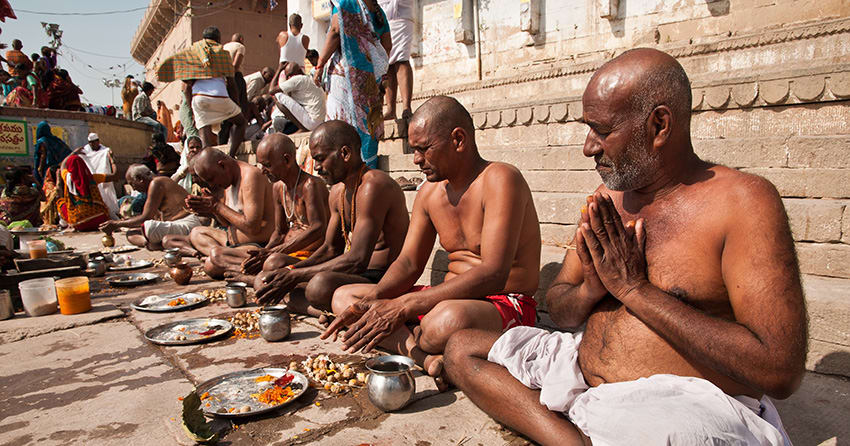Brahmins in dire straits

This is about modern-day Brahmins. Many do not seem to be aware that Brahmins who were once the leading lights of our society are now in dire straits, socially, economically and politically despite some of them doing well in some fields. This is what modern times have brought them to. The hiatus has increased multifold between Brahmins who are well to do and Brahmins who barely subsist?
Can you just imagine Brahmins working as cleaners in sauchalayas (public toilets) in Delhi and other places; as porters, bearers, waiters, rickshaw pullers and in several other jobs to earn some money for survival? Economically most of them are hard hit and their situation has deteriorated over the years.
Several reasons are assigned for it. One, the social progress seems to have bypassed them and they remained as history’s ignored children in developing India. Second, there is no unity among the Brahmins, divided as they are not only between the north and the south but also due to their various social status, nomenclatures and regional variations.
Further, there is no mutual help among them. It is alleged and probably rightly so that a Brahmin normally does not render any assistance to another Brahmin to help him grow. This selfishness probably originates from the old purohit (priest) and jajman (client) relationship where the Brahmin fiercely protected his disciples and the disciples too remained attached to their kul purohit (family priest) through generations.
Another reason that is expressed only privately is that while Dalits have reservations and they are thriving, there are no such measures to help economically poor Brahmins. In fact, it is argued that reservations in jobs should be on the basis of economic status, not social status. Many Brahmins have moved to cities and towns leaving their ancestral villages in search of jobs other than priesthood and teaching which are no longer paying.
It is not at all fortuitous that many Tamil Brahmins have migrated abroad and joined avocations where they have thrived. Some Brahmins have also developed a network of priesthood abroad where many migrated Indians seek assistance of Brahmin priests for various functions.
This author himself is witness to a Durga Puja many years ago, in Berlin where the priest was invited to come from Frankfurt where he was employed at the airport as a ground engineer. This writer himself was invited to read out the Lakshmi stotra (verses for Goddess Lakshmi) during Lakshmi puja in Helsinki where the household was a non-Brahmin one.
Brahmins who went abroad are these days not only earning well but also prospering and are doing exceptional work in the countries they reside, not because they are Brahmins but because they have used their intellectual prowess and perseverance to move ahead. Of the 10 Indian-origin MPs elected to British Parliament, five are Brahmins.
One can find among the Brahmin Diaspora, Nobel laureates, well known applied scientists, space technologists, nuclear scientists, medical notables, surgeons, academicians, politicians, and so on.
There is a very wellknown Brahmin Samaj in USA which is doing very useful work for the last nearly 30 years. It was set up in New Jersey and has now spread to many places.
In our own country, due to economic difficulties many Brahmin students give up their studies quite early. Few are able to continue in schools and colleges; they fall back upon either the traditional priesthood or take to other professions migrating from their villages.
According to a study, in Bihar and UP villages, populations are predominantly Dalits and that is why most of the lawmakers come from their communities.
Only 5 seats out of 600 in the combined UP and Bihar assemblies were held by Brahmins (2006) — the rest were mostly Yadavs. A report in The Times of India (November 11, 2015) showed that 25 per cent of the new Bihar assembly consisted of Yadavs, and Brahmins elected to that body were only four per cent. Together with Bhumihars, they constituted 11 per cent of the MLAs. In 1962 Brahmins alone constituted 13.9 per cent.
A study of the Brahmin community in a district in Andhra Pradesh (BRAHMINS OF INDIA by J Radhakrishna, Chugh Publications) reveals that today all purohits live below the poverty line. 80 per cent of those surveyed stated that their poverty and traditional style of dress and hair (tuft) had made them the butt of ridicule. Financial constraints coupled with the existing system of reservations for the ‘backward classes’ prevented them from providing secular or holistic education to their children.
The study also found that 55 per cent of all Brahmins lived below the poverty line — below a per capita income of Rs 650 a month. Since 45 per cent of the total population of India is officially stated to be below the poverty line, it follows that the percentage of destitute Brahmins is 10 per cent higher than the all-India below poverty line figure.
There are some organisations of Brahmins in many places but these seem mostly narrow in their viewpoints. Some even describe themselves as World Brahmin Federation, International Brahmin Council and so on. But the real work of unity and development that is required seems to be eluding these bodies. This is what is needed now to go ahead and unite all Brahmins. It is not a parochial approach but embracing all, not Brahmins in isolation.
